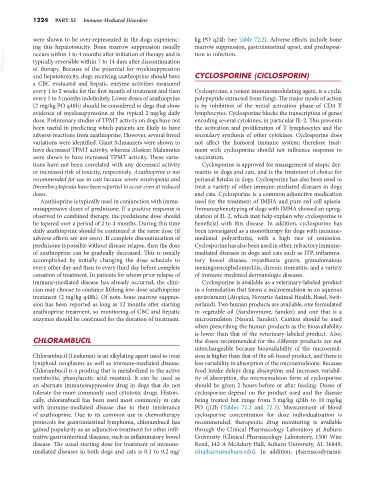Page 1252 - Small Animal Internal Medicine, 6th Edition
P. 1252
1224 PART XI Immune-Mediated Disorders
were shown to be over-represented in the dogs experienc- kg PO q24h (see Table 72.2). Adverse effects include bone
ing this hepatotoxicity. Bone marrow suppression usually marrow suppression, gastrointestinal upset, and predisposi-
VetBooks.ir occurs within 1 to 4 months after initiation of therapy and is tion to infection.
typically reversible within 7 to 14 days after discontinuation
of therapy. Because of the potential for myelosuppression
and hepatotoxicity, dogs receiving azathioprine should have CYCLOSPORINE (CICLOSPORIN)
a CBC evaluated and hepatic enzyme activities measured
every 1 to 2 weeks for the first month of treatment and then Cyclosporine, a potent immunomodulating agent, is a cyclic
every 1 to 3 months indefinitely. Lower doses of azathioprine polypeptide extracted from fungi. The major mode of action
(2 mg/kg PO q48h) should be considered in dogs that show is by inhibition of the initial activation phase of CD4 T
evidence of myelosuppression at the typical 2 mg/kg daily lymphocytes. Cyclosporine blocks the transcription of genes
dose. Preliminary studies of TPMT activity on dogs have not encoding several cytokines, in particular IL-2. This prevents
been useful in predicting which patients are likely to have the activation and proliferation of T lymphocytes and the
adverse reactions from azathioprine. However, several breed secondary synthesis of other cytokines. Cyclosporine does
variations were identified. Giant Schnauzers were shown to not affect the humoral immune system; therefore treat-
have decreased TPMT activity, whereas Alaskan Malamutes ment with cyclosporine should not influence response to
were shown to have increased TPMT activity. These varia- vaccination.
tions have not been correlated with any decreased activity Cyclosporine is approved for management of atopic der-
or increased risk of toxicity, respectively. Azathioprine is not matitis in dogs and cats, and is the treatment of choice for
recommended for use in cats because severe neutropenia and perianal fistulas in dogs. Cyclosporine has also been used to
thrombocytopenia have been reported to occur even at reduced treat a variety of other immune-mediated diseases in dogs
doses. and cats. Cyclosporine is a common adjunctive medication
Azathioprine is typically used in conjunction with immu- used for the treatment of IMHA and pure red cell aplasia.
nosuppressive doses of prednisone. If a positive response is Immunophenotyping of dogs with IMHA showed an upreg-
observed to combined therapy, the prednisone dose should ulation of IL-2, which may help explain why cyclosporine is
be tapered over a period of 2 to 4 months. During this time beneficial with this disease. In addition, cyclosporine has
daily azathioprine should be continued at the same dose (if been investigated as a monotherapy for dogs with immune-
adverse effects are not seen). If complete discontinuation of mediated polyarthritis, with a high rate of remission.
prednisone is possible without disease relapse, then the dose Cyclosporine has also been used in other, refractory immune-
of azathioprine can be gradually decreased. This is usually mediated diseases in dogs and cats such as ITP, inflamma-
accomplished by initially changing the dose schedule to tory bowel disease, myasthenia gravis, granulomatous
every other day and then to every third day before complete meningoencephalomyelitis, chronic stomatitis, and a variety
cessation of treatment. In patients for whom prior relapse of of immune-mediated dermatologic diseases.
immune-mediated disease has already occurred, the clini- Cyclosporine is available as a veterinary-labeled product
cian may choose to continue lifelong low-dose azathioprine in a formulation that forms a microemulsion in an aqueous
treatment (2 mg/kg q48h). Of note, bone marrow suppres- environment (Atopica, Novartis Animal Health, Basel, Swit-
sion has been reported as long as 12 months after starting zerland). Two human products are available, one formulated
azathioprine treatment, so monitoring of CBC and hepatic in vegetable oil (Sandimmune, Sandoz) and one that is a
enzymes should be continued for the duration of treatment. microemulsion (Neoral, Sandoz). Caution should be used
when prescribing the human products as the bioavailability
is lower than that of the veterinary-labeled product. Also,
CHLORAMBUCIL the doses recommended for the different products are not
interchangeable because bioavailability of the microemul-
Chlorambucil (Leukeran) is an alkylating agent used to treat sion is higher than that of the oil-based product, and there is
lymphoid neoplasms as well as immune-mediated disease. less variability in absorption of the microemulsions. Because
Chlorambucil is a prodrug that is metabolized to the active food intake delays drug absorption and increases variabil-
metabolite, phenylacetic acid mustard. It can be used as ity of absorption, the microemulsion form of cyclosporine
an alternate immunosuppressive drug in dogs that do not should be given 2 hours before or after feeding. Doses of
tolerate the more commonly used cytotoxic drugs. Histori- cyclosporine depend on the product used and the disease
cally, chlorambucil has been used most commonly in cats being treated but range from 5 mg/kg q24h to 10 mg/kg
with immune-mediated disease due to their intolerance PO q12h (Tables 72.2 and 72.3). Measurement of blood
of azathioprine. Due to its common use in chemotherapy cyclosporine concentration for dose individualization is
protocols for gastrointestinal lymphoma, chlorambucil has recommended; therapeutic drug monitoring is available
gained popularity as an adjunctive treatment for other infil- through the Clinical Pharmacology Laboratory at Auburn
trative gastrointestinal diseases, such as inflammatory bowel University (Clinical Pharmacology Laboratory, 1500 Wire
disease. The usual starting dose for treatment of immune- Road, 142-A McAdory Hall, Auburn University, AL 36849;
mediated diseases in both dogs and cats is 0.1 to 0.2 mg/ clinpharm@auburn.edu). In addition, pharmacodynamic

